Packing for the West Coast Trail can be a little bit confusing. Your pack needs to be light, but it also needs to contain everything you need, including lots of food and waterproof gear.
The first time I hiked the West Coast Trail in 2004 I was really inexperienced and used mostly borrowed gear. My pack was really heavy and I brought waaay too much clothing.
On my second trip in 2019, I did lots of gear research. I managed to put together a backpack full of gear that wasn’t too heavy or bulky but still kept me dry in the wet West Coast weather. In general, I was really happy with what I brought.
Here’s my complete West Coast Trail packing list. It includes everything you should bring on the West Coast Trail, plus my specific recommendations for gear.
Heads up: You can also use my West Coast Trail packing for the North Coast Trail, the Juan de Fuca Trail, and the Cape Scott Trail.
WANT MORE WEST COAST TRAIL INFO? Check out these posts:
- West Coast Trail Basics
- Section-By-Section Overview
- 7-Day West Coast Trail Itinerary (Plus More Itinerary Options)
- Complete Guide to Every Campground
- Transportation: How to Get There, Where to Stay Near the Trailheads
- Coastal Hiking Tips: Advice for Beach Backpacking
Hey there: Some of the links in this post are affiliate links, which means I earn a small commission at no extra cost to you if you make a purchase. Thanks for supporting my website! -Taryn
West Coast Trail Pack Weight
Before we get into my West Coast Trail packing list, I wanted to take a minute to talk about pack weight.
Even if you’re an experienced backpacker, the West Coast Trail is unusual: it’s a long trip (typically 7 days) and it involves ladders, tons of mud, lots of rain, technical terrain and beach walking – things you don’t find on most other backpacking trips. There can be a bit of a temptation to overpack for a bunch of just-in-case scenarios.
And yes, you do want to make sure you are prepared and you don’t leave behind anything crucial. But at the same time, you want to make sure you aren’t carrying a ridiculous amount of weight.
In general, Parks Canada recommends that you pack weight 15-20% of your body weight. In practice, that means your pack should weigh somewhere between 25 and 40 pounds. However, it’s really easy to accidentally carry more.
On my 2019 West Coast Trail trip my friends and I’s packs weighed between 35 and 60 pounds. And we all agreed we could have shaved down our pack weight more and had a better time. Especially the guy who carried the 60-pound pack – it contained sooo much extra food!
(For reference, my pack weighed 37 pounds on day 1 and 27 pounds on the last day. Apparently I carried a LOT of food.)
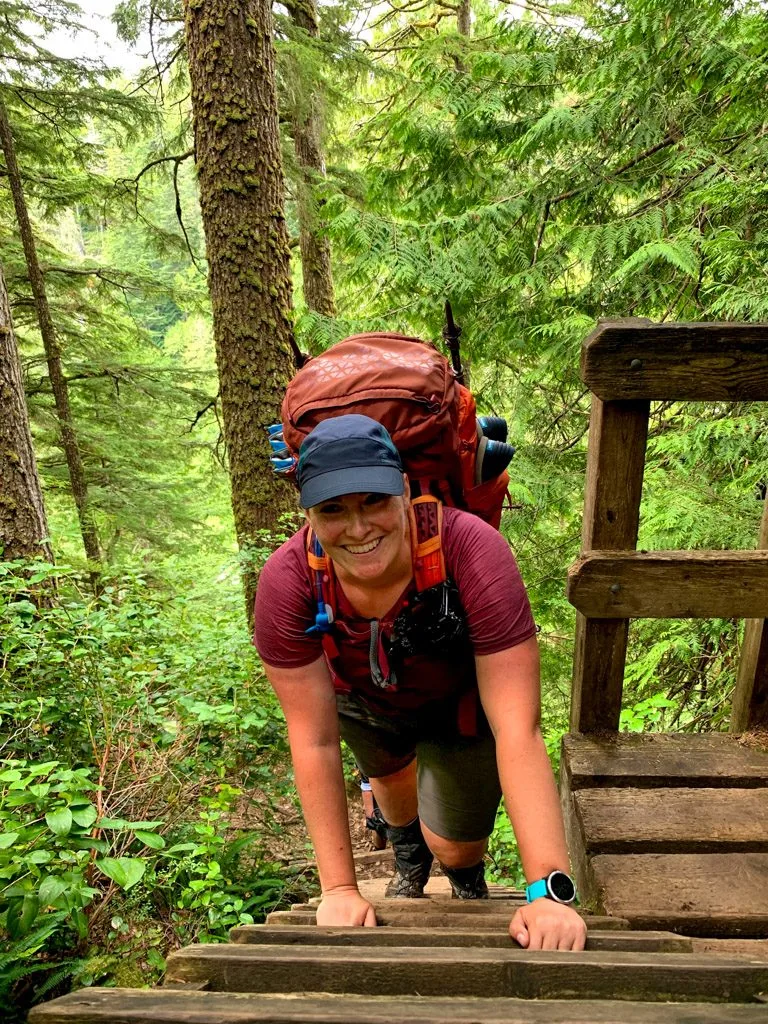
Tips for Reducing Pack Weight on the West Coat Trail
Here are my main tips for reducing pack weight:
- Go lightweight for your big items: sleeping bag, tent, backpack, and sleeping pad
- Don’t bring too many clothes on the West Coast Trail. You don’t need fresh underwear every day! You don’t need clean clothes!
- Think about the coldest temperature you’ll face. Put together a combination of clothing layers could you wear in that temperature and stay warm. And then don’t pack more clothes than that.
- Save weight on food. Look at calorie counts and weight carefully.
- Forego luxuries. Leave the chair, hammock, heavy camera lenses, etc. at home.
- Share gear with your group. Together you only need one tarp, first aid kit, water filter, etc.
We actually have a basic luggage scale we use to weigh our packs. We put it in the car so we can weigh packs at the start of backpacking trips. It’s this one.
On the West Coast Trail there are scales you can use to weigh your pack on the front porch of the Pachena Bay ranger station, at Butch’s dock on Gordon River, and at the Crab Shack at Nitinaht Narrows.
Want more tips? I have a whole post about how to reduce your pack weight!
West Coast Trail Essentials
Trail Permit
When you check-in at the ranger station during your orientation session, the ranger will give you a small paper permit. It’s not waterproof so bring a ziploc bag to keep it in. When you take the ferries at Gordon River and Nitinaht Narrows, the ferry operator will ask to see your permit. If you don’t have your permit, you can’t get on the ferry.
For more information on how to make a West Coast Trail reservation, get permits and how much they cost, see my Guide to the West Coast Trail.
National Parks Pass
You need a National Parks pass to hike the West Coast Trail. You can buy one when you check-in to start the trail, or bring your annual pass if you already have one. They aren’t waterproof, so stick them in the same ziploc bag you put your permit in.
West Coast Trail Map
Pretty much the most important thing you will carry on the entire West Coast Trail is your map. When you check-in at your orientation session, the ranger will give you a waterproof copy of the trail map. You will want to refer to it multiple times a day to see how far away campsites and water sources are or to figure out if you should take the beach route or the forest route.
Tide Table
The second most important thing you need on the West Coast Trail is a tide table. The park ranger will tape a basic tide table to your West Coast Trail map. HOWEVER… it’s basic. Too basic. All it has are the daily high and low tides. AND it hasn’t been adjusted for daylight savings time so if you choose to use it you’ll have to mentally add an hour to the times.
A MUCH better option is to bring your own tide table. You can print out a tide table from Fisheries and Oceans Canada that IS adjusted for daylight savings time AND has the hourly predicted tide height for every hour of the day. No more guessing!
Print out the Tofino tide table, then put it in your trusty ziploc bag. (If like me you’re a nerd and you were wondering why Parks Canada recommends using the Tofino tide table and not the Port Renfrew or Bamfield tide tables (which are closer to the trail), it’s because Tofino is more open ocean conditions similar to what you get on the WCT. Port Renfrew and Bamfield are both in long inlets that have different tidal behaviour. The more you know, right?)
Bring a tide table is one of my top coastal hiking tips.
Watch or Cell Phone
Having a tide table is pretty much useless without a way to tell time. Bring a watch or use your phone to tell the time. If you use your phone, make sure you close all the apps you aren’t using, put it in airplane mode, and turn on power-saving mode so you maximize battery life. We carried a small battery pack to recharge our phones and were glad to have it.
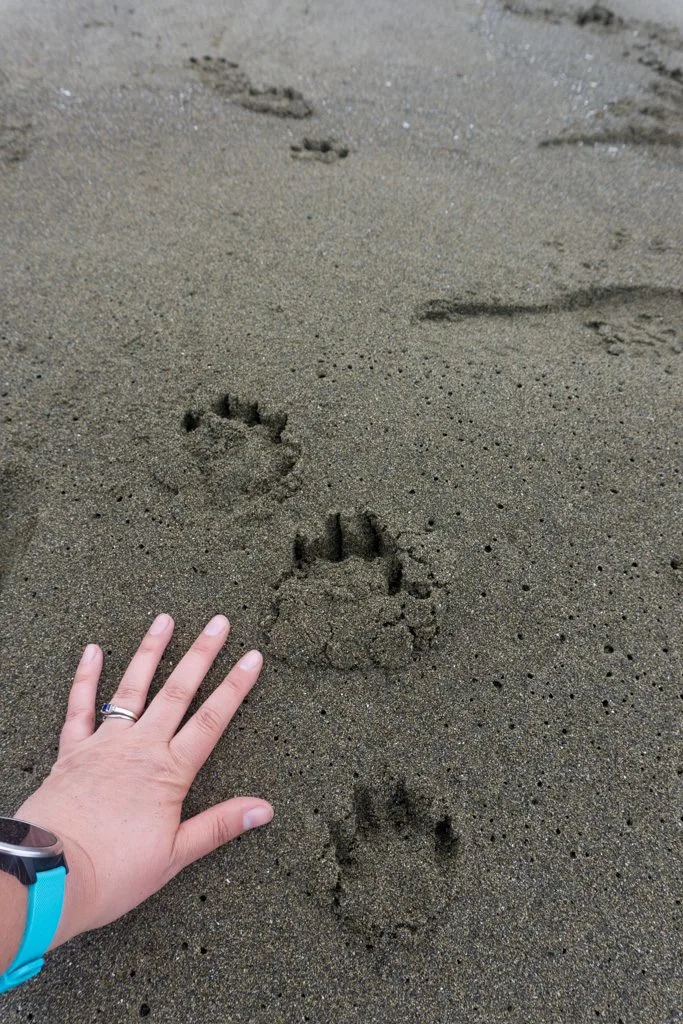
Guidebook (Optional)
I didn’t bring a guidebook on the West Coast Trail, but I did read a few before I left. I used Blisters and Bliss: A Trekker’s Guide to the West Coast Trail, and Hiking the West Coast of Vancouver Island, which has a long section on the West Coast Trail. Instead of bringing the whole book, I took photos of the most relevant pages on my phone, then looked at them on the trail.
GPS (Optional)
We used the Gaia GPS app on our phones and our Garmin GPS watches on the West Coast Trail. It was nice to know how far we had walked and to be able to gauge how far it was to the next landmark.
We also used our GPS to figure out that the kilometre markers on the West Coast Trail are usually not in the right place. When we felt tired, we could look at our GPS and see that while we thought we would be walking 10km, we had actually walked 12 or more! It made us feel a bit better about ourselves!
(Psst! Want to save 20% on a Gaia GPS premium annual membership, which gets you the same maps I used on the West Coast Trail? Use this link.)
I have a Garmin vivoactive 3 that keeps track of my distance, heart rate, etc. I swapped out the plain black band for this fun (and cheap!) blue one. My husband has a Garmin Fenix 5 that you can load maps on to, which is MUCH more helpful for hiking.
Join the Backpacking in BC Facebook Group
Backpacks and Bags
Backpack
When looking for a backpack, choose something between 60 and 75L. Do a test pack at home to make sure all your gear fits. Make sure you pick a backpack that fits you well and is comfortable to carry.
I used my old (and discontinued) Boreas Lost Coast 60 on the West Coast Trail. My husband and a couple of our friends brought their Gregory Stout 75 and Gregory Amber 60 (the women’s version). In general, they said the packs were comfortable, even under heavy loads.
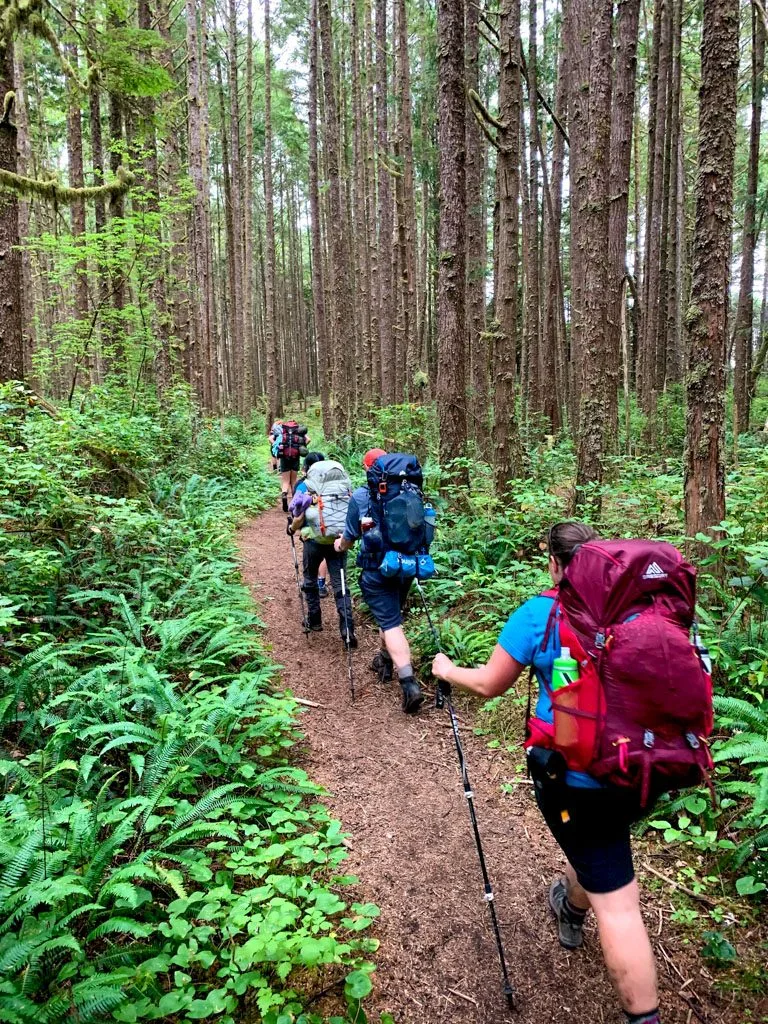
Stuff Sacks and Organizers
To stay organized I like to pack my gear in a combination of different sized stuff sacks. Mostly I use lightweight dry bags. It can rain a LOT on the West Coast Trail so keeping your gear dry is really important.
I like the Sea to Summit Ultra-Sil window dry bags. They’re waterproof but still incredibly lightweight. Plus they have a clear panel so you can see what’s inside.
Rain Protection
If your gear gets wet, it can really ruin your trip. Thankfully, on my trip, we had hardly any rain. However, the week before there was record-setting rainfall – almost 100mm in one day!
I brought a rain cover for my backpack. Some packs come with a custom-sized rain cover. If yours didn’t, buy a lightweight silnylon one that fits your pack well. Pro tip: If you tend to overstuff your pack or attach things to the outside, buy a slightly larger sized rain cover.
I also lined the inside of my pack with a trash compactor bag. They are HUGE plastic garbage bags that are much more durable than a standard garbage bag since they are designed to go inside a kitchen trash compactor. Some hikers report that they can use the same one for several years before it develops holes. They are hard to find in Canada so it’s easiest to order them online.
Tent and Sleeping Gear
Tent
The West Coast Trail sees some serious bad weather and heavy rain. You need a proper backpacking tent that is lightweight, compact and has a full-length waterproof rain fly. This isn’t the place for a cheap, big-box store tent that will leak.
We actually brought our ultralight Zpacks Triplex on the West Coast Trail. It’s a single wall tent, so we did have a bit of condensation inside, but for me, the weight savings were worth it.
The Triplex is a niche, ultralight tent, so if you’re looking for something more mainstream, I recommend the MSR Hubba Hubba NX. I’ve been using one for over a decade and I can’t say enough good things about it. (Well except that it isn’t cheap!) If the Hubba Hubba isn’t in your budget, check out the MSR Elixir.
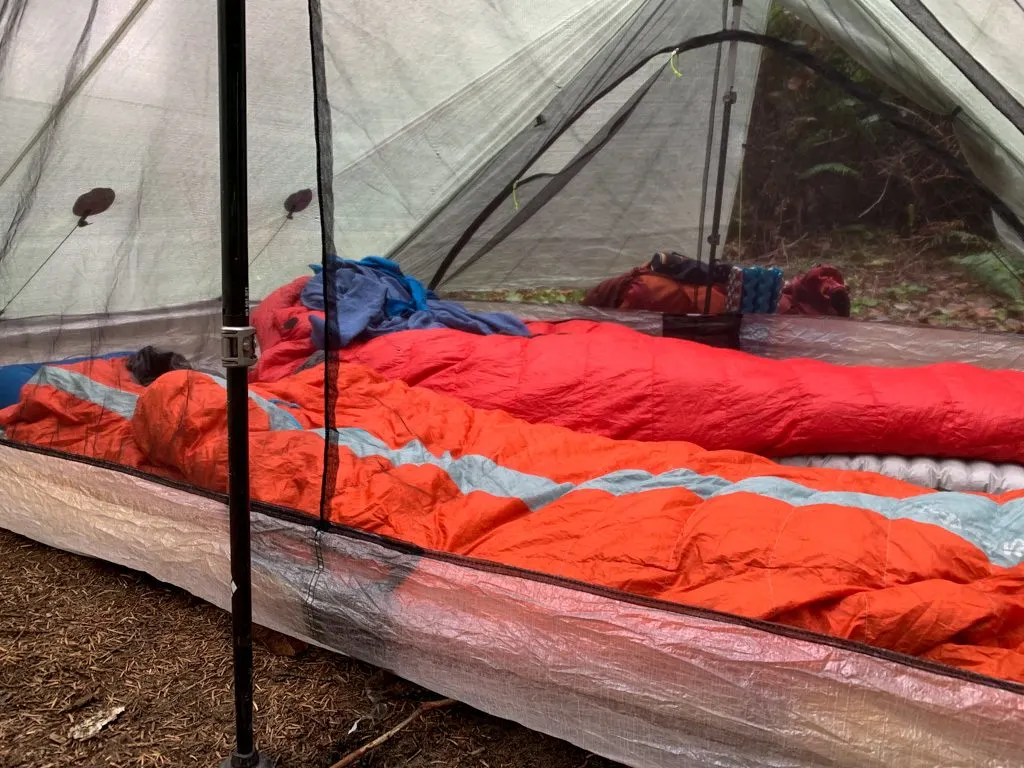
Tent Pegs
Most of the campgrounds are the West Coast Trail are sandy, which can make it difficult to peg out a tent. (See my guide to camping on the West Coast Trail for more info on what the campgrounds are like.)
You can bring the regular pegs that came with your tent, but be prepared to put rocks on top of them to make sure they stay put in the soft sand. Another option is snow stakes (which double as sand stakes), but they are pretty heavy so I opted not to bring them.
You may also want to bring a few extra lengths of guyline. Tie your tent out to rocks or pieces of driftwood. My Zpacks tent is not free-standing, which means it needs to be guyed out really well to stand up properly. We brought a few cheap hardware store screw-in eyelets. Screw them into a handy piece of driftwood, tie on the guyline. Easy-peasy.
Tarp and Cord (Optional)
You’ll be lucky if you can hike the entire West Coast Trail without being rained on. It’s a good idea to add a lightweight silnylon tarp to your West Coast Trail packing list. It’s great for cooking and hanging out under at camp. It also doubles as a great sunshade if you are lucky enough to need one.
We brought an 8’x10′ RAB Siltarp 2 that was big enough to fit our entire group. You’ll also want to bring lots of cord and some extra pegs to help set it up.
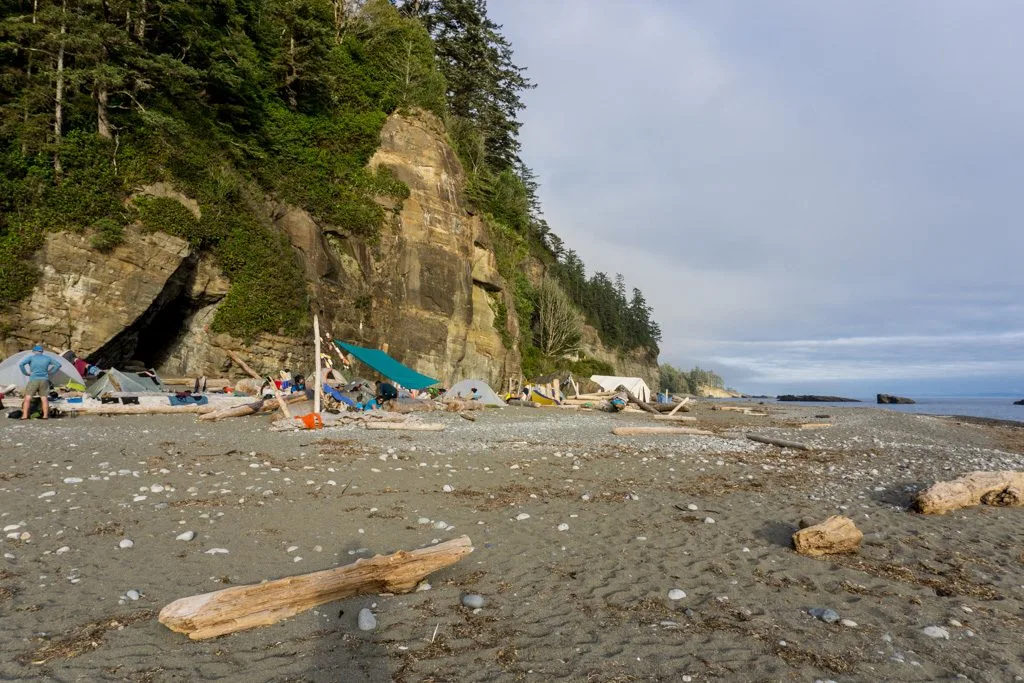
Sleeping Bag and Compression Sack
The weather on the West Coast Trail is pretty mild. It’s never too cold, but it’s also never too hot either. (Check out the weather section of my Ultimate Guide to the West Coast Trail for more info.) I recommend packing a lightweight and compressible sleeping bag rated at least +10C but preferably more like 0C.
Many people say you need to use a synthetic sleeping bag on the West Coast Trail since down bags don’t keep you warm when they get wet.
I don’t agree. I think you can use a down or a synthetic sleeping bag on the West Coast Trail. I’ve used a down sleeping bag on both my trips and countless other wet British Columbia backpacking trips.
If you use a quality waterproof tent, pack your sleeping bag inside a water-resistant stuff sack or dry bag, wrap that stuff sack in a garbage bag, use a pack liner and a rain cover, it’s pretty hard to get your sleeping bag wet. I wouldn’t worry about your down bag if you take care of it properly.
I used a really old MEC sleeping bag on the West Coast Trail that is rated about 0C. (It’s the predecessor to the MEC Talon.) It was warm enough at night that I never needed to zip it up all the way. My friend brought her new Therm-a-rest Space Cowboy +7C sleeping bag on the West Coast Trail. She was impressed at how small it packed down and how warm it was.
Make sure you pack your sleeping bag inside a compression sack so it takes up less space in your pack. I like the Outdoor Research Ultralight Compression sacks since they come in lots of sizes.
Sleeping Pad
While all the West Coast Trail campsites are on the sand, it’s not always soft and the warmest sleeping bag can’t protect you from the cold ground. You’ll need a sleeping pad for that. Choose one that is compact, lightweight and has an R-value of at least 2.5. (R-value measures insulation and warmth).
If you expect cold weather or know you feel the cold at night, pick a pad with an even higher R-value. I use a Therm-a-rest NeoAir Xtherm since I sleep really cold. (Although it was probably overkill for the West Coast Trail.) My husband likes his NeoAir XLite which weighs less but isn’t quite as warm.
Pillow (Optional)
You can use a bunched up jacket as a pillow, but I recommend adding a compact camping pillow to your West Coast Trail packing list. Your neck will thank you. I use a simple MEC inflatable pillow. For a slightly more deluxe experience check out the Sea to Summit Aeros Pillow Premium.
Ear Plugs (Optional)
Some of the West Coast Trail campsites get really crowded, which means your tent will be a few feet from your snoring neighbours. And while you might be on an early morning schedule, inevitably the people next door will be night owls. And there’s the sound of the waves. It might sound soothing at first, but it can be LOUD.
If you’re a light sleeper, I recommend bringing a few pairs of foam ear plugs. You’re bound to lose some so it’s good to have extras. I like the contoured ones since I find they fit in my ears better.
Clothing
Rain jacket
I can’t imagine doing the West Coast Trail without a good rain jacket. And even if it doesn’t rain, it will block the wind. Add a waterproof breathable rain jacket designed for hiking to your West Coast Trail packing list – preferably one with pit zips for venting. It’s HUMID out there.
I didn’t get much rain on my most recent West Coast Trail hike, but we did get a bit. I brought my new MEC Flash Cloud Gore-Tex jacket. It’s incredibly light so it didn’t take up much space in my pack on the days I didn’t wear it.
If you want something less expensive but still very lightweight, the Outdoor Research Helium II is a great option.
READ NEXT: Why Do Rain Jackets Wet Out?
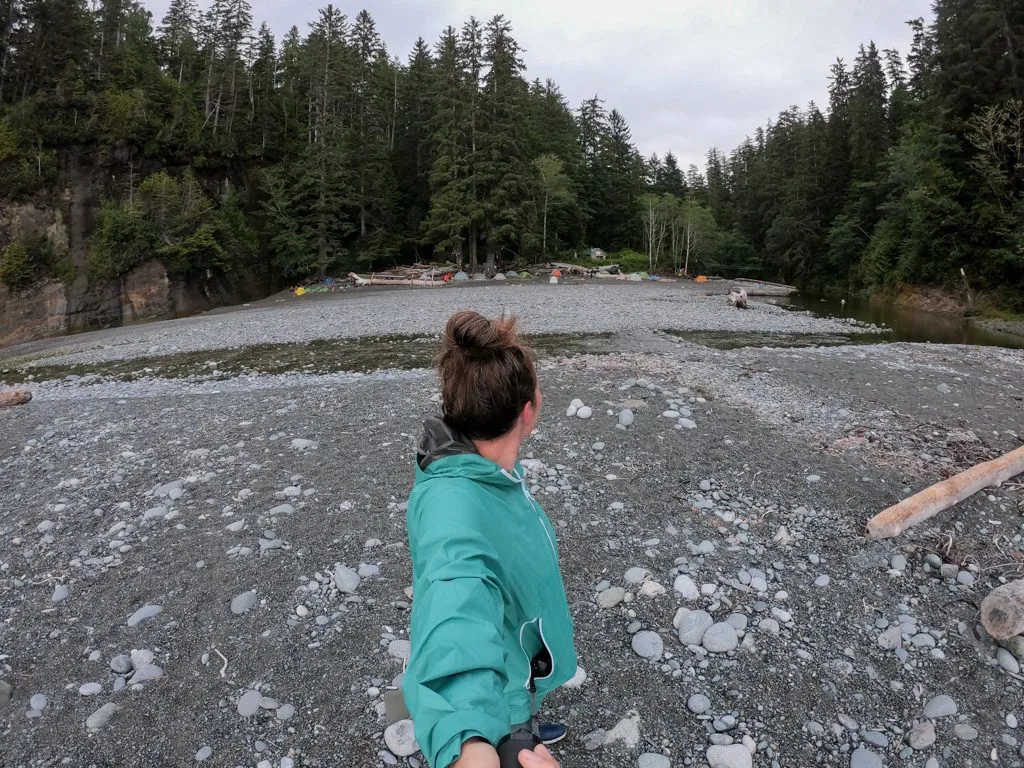
Rain Pants
Pack a pair of waterproof breathable rain pants that you can easily layer over top of your hiking pants. I didn’t need to use mine the last time I hiked the West Coast Trail, but I’ve definitely been glad to have them on cold and wet days in the past. Ones with side zippers for venting are easy to put on and take off without removing your shoes.
I have the MEC Hydrofoil Stretch Rain Pants. They have full-length side zips so they aren’t as light as the popular Outdoor Research Helium Pants.
Fleece Jacket or Light Weight Puffy Jacket
After dark or when the wind picks up, it can get a little cold on the West Coast Trail. Pack a fleece jacket or a lightweight puffy jacket that you can layer on over a t-shirt and under your rain jacket.
I brought my MEC Rockwall fleece jacket and wore it every night in camp. My husband brought his Patagonia Nano Puff Jacket. He wore it in camp on a few of the colder nights. For a synthetic puffy it’s really light and warm. It comes in a women’s version too.
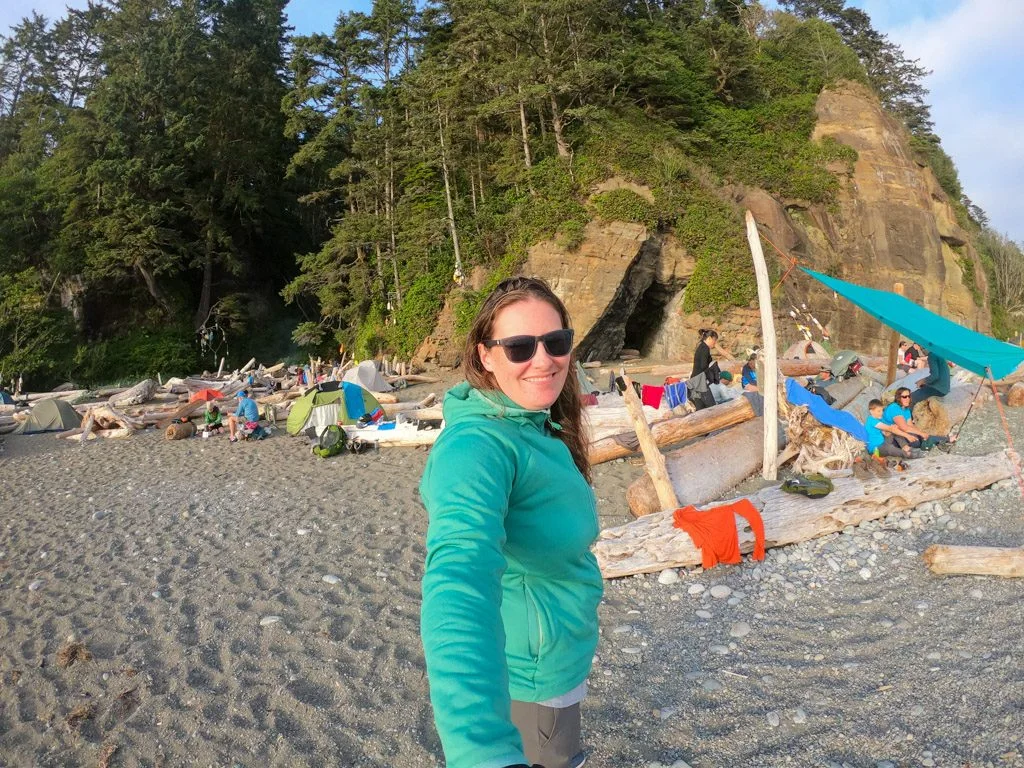
Hiking pants or tights (1 pair)
Choose quick-drying hiking pants made of nylon or polyester (and maybe with a bit of spandex for stretch).
Many women prefer to hike in tights or leggings, but I wouldn’t recommend them for this hike since they are prone to tearing and snagging. You’ll be doing lots of scrambling across rocks, dodging brush and even butt scooting on logs. It’s waaaay too easy to tear leggings that way.
However, you can buy reinforced hiking tights that could work on the WCT. Read my guide to the best hiking leggings for recommendations.
I love my MEC Terrena Stretch pants and brought them on the West Coast Trail. I also like the Prana Halle Pants. If you like pants that convert into shorts, the Halles come in a convertible version. The men’s version of the Prana Halle are the Stretch Zion pants.
READ NEXT: 12 Best Women’s Hiking Pants (Picks for Every Body Type)
Shorts (1 pair) (Optional)
In July and August, the weather on the West Coast Trail is warm enough for shorts. You may find you want shorts in May, June, and September too. However, some people prefer to hike the West Coast Trail in pants no matter the season to protect from rain, bugs, and scratches.
I’m a shorts person and wore shorts every day on both of my West Coast Trail hikes. The Black Diamond Valley Shorts are my favourite hiking shorts. They’re really lightweight, stretchy, dry quickly and aren’t too short. They also come in a men’s version.
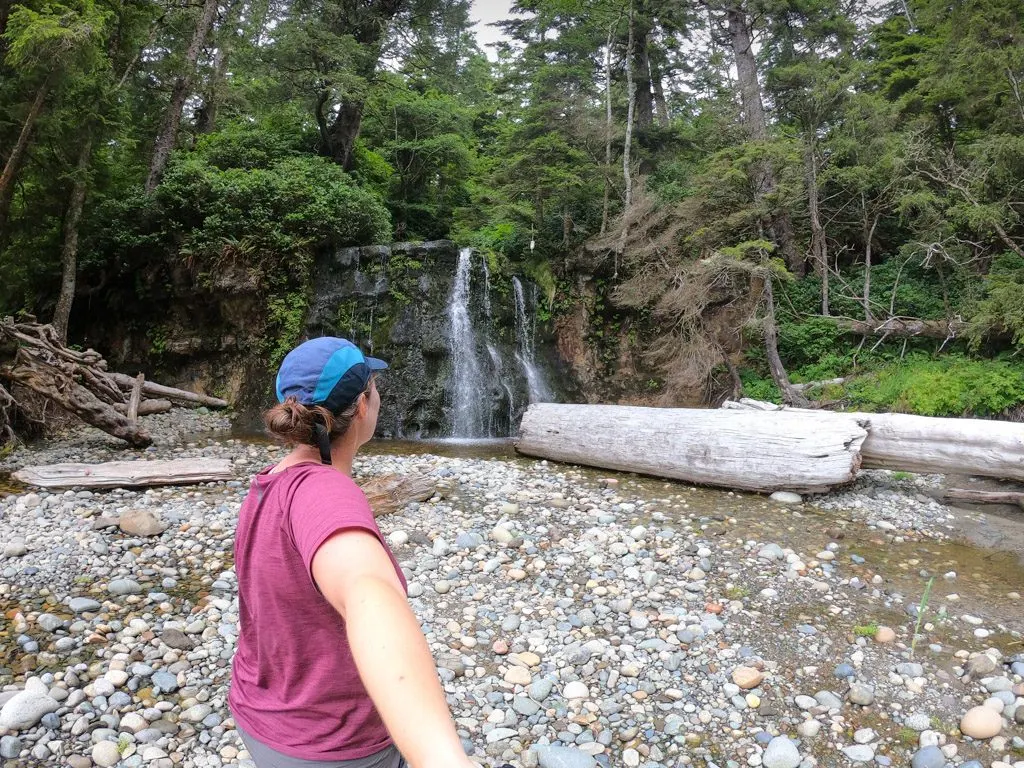
Shirts (2)
I usually hike in quick-drying workout t-shirts. On the West Coast Trail, I brought one short-sleeved t-shirt and one long-sleeved button-up shirt.
Mostly I wore the short-sleeved shirt, but the long-sleeved shirt was great for sun protection on the hotter beach days. I also brought a tank top that I wore a couple times in camp. But in retrospect, I definitely didn’t need it.
I love the Patagonia Capilene Cool Trail t-shirt since it looks like a regular t-shirt but wicks sweat and resists odours. But any old quick-dry polyester workout t-shirt will do.
For a long-sleeved shirt, I brought an older version of the MEC Sun Dodger Shirt. Even though it has long sleeves, since it’s so lightweight it doesn’t feel hot. If you’re shopping for a long-sleeved shirt, look for one with UPF protection.
Sleeping and Camp Clothes
When you get to camp, you’ll want to take off your sweaty hiking clothes and put on something a little fresher. You’ll also want something warm and dry to sleep in.
I brought some lightweight long underwear to wear at camp and to sleep in. (Although, mostly I wore my long-sleeved shirt and hiking pants around camp, then changed into thermals just to sleep.)
For bottoms, I brought Smartwool merino wool long johns that can pass as tights so I can wear them around camp. I also brought a MEC T3 Hoodie which is so cozy soft and warm, yet really lightweight thanks to the waffle-cut fabric. My husband likes Patagonia’s Capilene Midweight long underwear.
Underwear (3 pairs)
I like to bring two kinds of underwear on long trips: two or three pairs of quick-drying synthetic underwear for hiking and one pair of comfortable cotton underwear for wearing at night.
You don’t need a fresh pair for every day. Let them air out at camp for an afternoon or two or rinse them in a stream, then wear them again. Seamless underwear will be way more comfortable for hiking since they prevent chafing.
I swear by Patagonia’s Active seamless underwear. Many of the guys I hike with swear by boxer briefs like the ones from Saxx with a built-in pouch to prevent their package from rubbing the inner thighs. For more hiking underwear recommendations, see my guide to hiking underwear.
Sports Bra
You don’t need a ton of support for trekking, so try to choose a bra without a lot of fabric layers that will take a long time to dry. I really like the Knixwear bras for trekking since they are super lightweight, don’t absorb too much moisture and are seamless so they don’t chafe
Toque or Buff
Bring a fleece or wool hat that covers your ears. Or bring a buff that you can wear as a hat, an ear warmer or a neck gaiter. It can get chilly at night on the West Coast Trail, especially in the spring and fall.
I brought both a toque and buff and ended up never wearing the toque. I brought a merino wool buff, which was cozy warm but still lightweight.
Sun Hat and Sunglasses
The sun can be harsh on the West Coast Trail especially when it reflects off the water. Bring a wide-brimmed hat or baseball cap and a pair of sunglasses for protection. If you’re hiking south to north, you will have the sun at your back all day so you may want a hat that protects the back of your neck.
I like to wear polarized sunglasses as they let you see into the water better, which is great for tidepools. I love my Sunskis since they have fun frame options and they aren’t too expensive for polarized glasses.
Gloves (Optional)
Some people swear by having simple fleece gloves on the West Coast Trail, but I never used mine. They would be helpful in spring and fall when it’s chilly at night, or if you get cold hands during long days hiking in the rain, but if you’re hiking in July or August, I don’t think they are necessary.
Some people also like them to protect their hands on the ladders, cable cars and beach boulder section around Owen Point. They bring work gloves or garden gloves. I have soft city-girl hands and didn’t wear work gloves. It was totally fine and I didn’t miss them.
Join the Backpacking in BC Facebook Group
Footwear
Hiking Boots
The West Coast Trail is muddy and WET. Having waterproof boots is SO important. As well, make sure you bring boots that offer a bit of ankle support, especially if you are carrying a heavier pack than usual or don’t have strong ankles.
The most important thing is to bring boots that you’ve already worn already and that are comfortable. You really want to take care of your feet.
(Funny story – I forgot my boots at home when I hiked the West Coast Trail in 2019. I discovered they were missing when I was in Nanaimo on my way to the trail. Thankfully I was able to visit a local outdoor store and buy the exact same boots I already owned in the exact same size. And I didn’t have a single blister on the trail!)
I wore Salomon X Ultra Mid GTX boots on the West Coast Trail. They aren’t a full leather boot. Instead, they use a durable fabric outer and a waterproof breathable membrane which kept me totally dry. They are lightweight and not too stiff, so they didn’t feel heavy and clunky like leather boots can. They have mid-cut ankle support, which was enough for me.
If you want more support, my husband wore a higher cut version of my boots called the Salomon Quest GTX. He loves them.
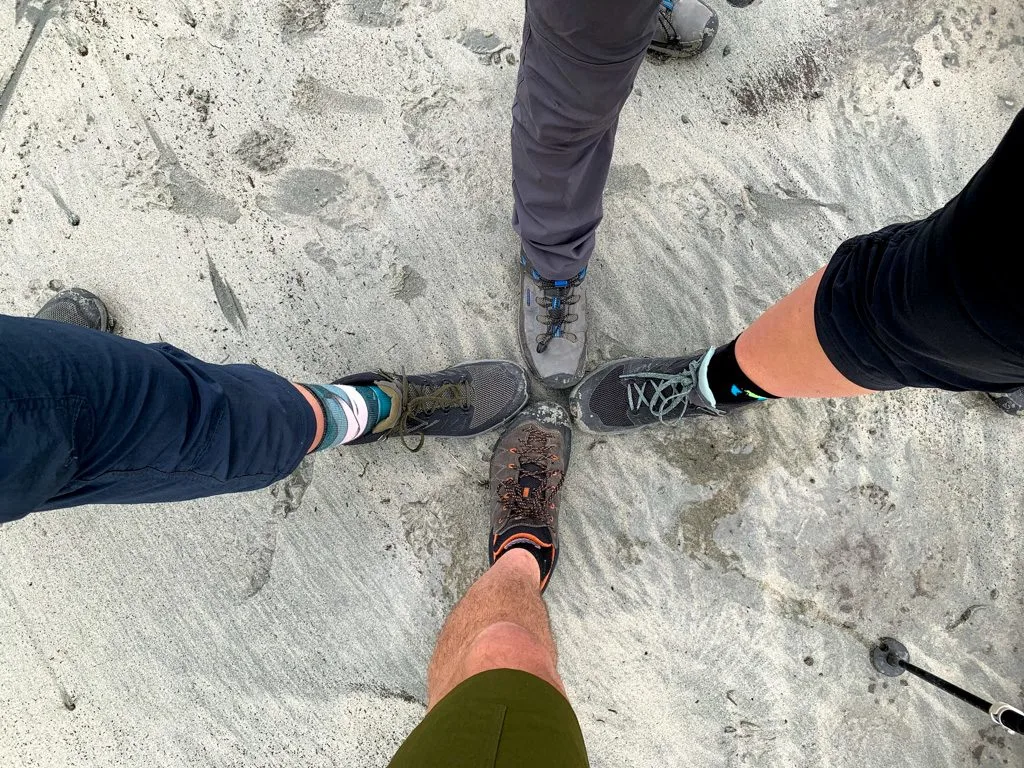
Camp/River Crossing Shoes (Optional)
It’s nice not to wear your boots all day. Pack a lightweight pair of shoes or sandals for around camp. Pick ones that are light and don’t take up too much room in your pack. If you also plan to wear them for river-crossings, pick something with a heel strap so they won’t slip off in the water.
I brought a pair of slip-on foam shoes. They were super light and they stayed on well for river crossings. Native Shoes makes some that are really similar to mine. A few people in my group had Crocs, which they loved.
One guy didn’t bring camp shoes at all. He crossed the rivers barefoot and walked around camp barefoot since most of the campsites were sandy. He said he didn’t regret not having camp shoes at all.
Socks (3 or 4 pairs)
Keeping your feet happy on the West Coast Trail is super important. Pack 3 or 4 pairs of wool and synthetic blend socks that fit well. I also wear liner socks since they can help reduce the rubbing that can cause blisters.
Try your socks and boots at home before your trek to make sure they don’t cause any problems. Air your socks out when you get to camp to keep them fresh.
I’m a recent convert to wearing Darn Tough socks. They’re comfortable and seem to last forever. I wear the Light Hiker Micro Crew. For liners, I love Injinji toe socks since they help prevent blisters between your toes. I wore my Injini liners every day on the West Coast Trail and had NO BLISTERS!
Gaiters (Optional)
Most people I saw on the West Coast Trail wore gaiters. They are helpful to keep mud, sand, and water out of your boots.
A few people in my group didn’t wear gaiters. Some wore pants to help things out of their boots, and others just stepped carefully. They all said they were fine without gaiters – but they definitely got muddy at times.
Personally, I always recommend that hikers wear gaiters on coastal trails. It’s one of my top tips for beach backpacking.
I brought a pair of basic MEC short gaiters on the West Coast Trail. They were the right height to protect from sand and mud, but they weren’t as hot and uncomfortable as tall, waterproof gaiters. The model I have is discontinued, but if you are buying gaiters specifically for the West Coast Trail, I’d recommend short gaiters designed for trail running since they are very lightweight.
Avoid anything with a zipper as they just get clogged with sand. I’ve been eyeing these Outdoor Research Thru Gaiters.
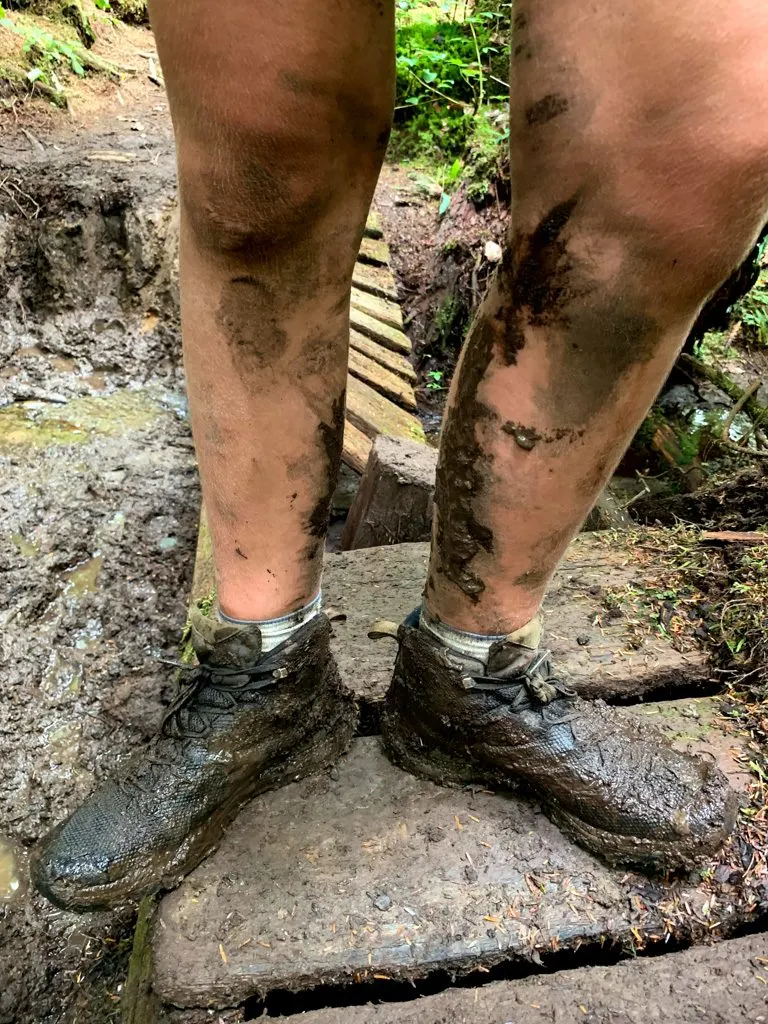
Toiletries, First Aid and Safety
Toothpaste and Toothbrush
I get travel-sized tubes of toothpaste from the dentist to take on hiking trips. I also use a Carry Clean toothbrush. It splits into two pieces, then you can nest the head inside the handle to keep it clean. AND it’s a lot shorter so it’s easier to fit into a smaller toiletry bag.
Deodorant, Baby Wipes and Face Cloth
You’ll be getting sweaty every day. Bring a small travel-sized deodorant and some baby wipes for having a quick sponge bath at the end of the day. I also brought a small quick-dry face cloth. I got it wet in the creeks, then used it to give my face and stinky parts a quick wipe down.
Sunscreen and Lip Balm
Pack sunscreen and SPF lip balm to protect yourself from the sun. I brought a Sun Bum sunscreen stick. It was really easy to just swipe an extra layer of sunscreen on my nose and cheeks without getting it all over my hands.
Bug Spray (Optional)
In general, the bugs aren’t bad on the West Coast Trail. There can be some mosquitos on the forested trails early in the season or in some of the forested campsites. However, it’s usually too breezy on the beach for most insects. I didn’t bring bug spray on the West Coast Trail and I didn’t miss it.
Hair Brush and Hair Ties
If you’ve got long hair, you know why you need these.
Glasses, Contact Solution and Spare Lenses
If you wear contacts, be sure to pack contact solution and extra lenses.
Toilet Paper and Hand Sanitizer
There are composting toilets at every campsite, but toilet paper isn’t supplied. Put toilet paper on your West Coast Trail packing list. Put it inside a Ziploc bag to keep it dry. Carry a small bottle of hand sanitizer to clean your hands after you use the toilet and before you eat.
Menstrual Supplies
If you expect your period on the trail, be sure to pack your favourite menstrual supplies. Learn more about how to camp and hike while on your period.
First Aid Kit
You should pack a small first aid kit. Make sure it includes bandages, gauze, medical tape and a compression bandage for sprains.
You’ll also want to have lots of foot care supplies such as Moleskin or Second Skin for blisters. (Check out my full list of blister care and prevention tips and tricks.) Bring anti-inflammatory painkillers, and anti-diarrhea pills just in case.
And of course, don’t forget your usual prescription medications.
I like the Adventure Medical Ultralight first aid kits since they come in a water-resistant pouch. I always add more stuff to them, like more blister care and bandaids
Your first aid kit should also contain stuff to help repair your gear in case you have any problems. We packed a small multi-tool and some gear repair tape.
Bear Spray
The West Coast Trail is home to black bears, wolves, and cougars, although you’re more likely to see tracks and poop than the animals themselves. Carry bear spray and make lots of noise when hiking.
Buy bear spray and a holster so you can attach it to your backpack or belt. I’ve got lots more tips for hiking and camping in bear country in this post.
Join the Backpacking in BC Facebook Group
Electronics
Camera
Of course, you can bring your phone to use as a camera, but you may want to bring a stand-alone camera. I brought my Sony A6000. It’s a mirrorless camera which is more compact than a full DSLR but still produces high-quality images. It’s easy to use, plus it’s not that expensive.
I use a Peak Design Capture clip to carry it on the shoulder strap of my pack so it’s easy to grab.
I also borrowed a GoPro Hero 7 Black to shoot some fun video footage on the trip. It was so fun to use that I bought my own Go Pro afterwards!
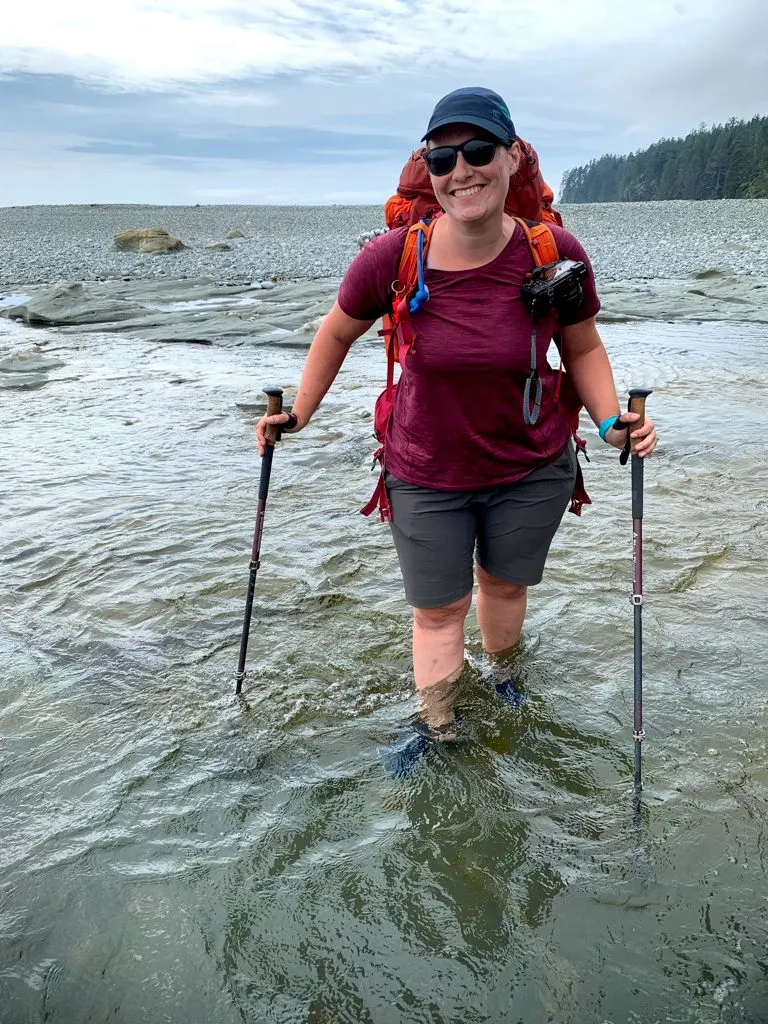
Headlamp
Bring a headlamp to find your way around after dark. I brought the Petzl Bindi. It’s TINY yet still quite bright. Plus its USB rechargeable, which is so much more convenient than buying AA batteries.
Power Bank/Portable Charger (Optional)
If you’re bringing electronics, you’ll need a way to keep them all charged. Some people like solar chargers, but with the cloudy weather on the West Coast Trail, a power bank is more reliable.
Bring a power bank that has enough storage to charge your devices at least once, but isn’t too big and heavy. The size you choose will depend on how many devices you bring, but at least 2,500mAh capacity or larger is probably a good idea.
Cooking Gear
Stove, Fuel, and Lighter
While you can have a fire on the beach on the West Coast Trail (as long as there isn’t a fire ban), often the wood is wet or there isn’t much of it. Plan to cook on a stove, rather than relying on a fire. Bring a lightweight and compact backpacking stove. And don’t forget a lighter!
Our friends brought their tiny Snow Peak Giga stove, which uses disposable fuel canisters. We have one too, but we opted to bring our Primus Omnifuel stove on the West Coast Trail. Since it was a longer trip, we wanted to bring a white gas stove so we could carry the exact amount of fuel we needed and not have to pack out empty canisters.
If you’re flying to Vancouver Island, remember that you can’t fly with fuel. Pick it up in Victoria or Nanaimo. You can also arrange to have the West Coast Trail bus driver bring you some fuel, but you need to book in advance.
Cooking Pot
Choose lightweight camping pots. Unless you are making elaborate meals, you probably just need one pot. We use a Primus Primetech pot that has a built-in heat exchanger that optimizes fuel consumption and protects the flame from the wind.
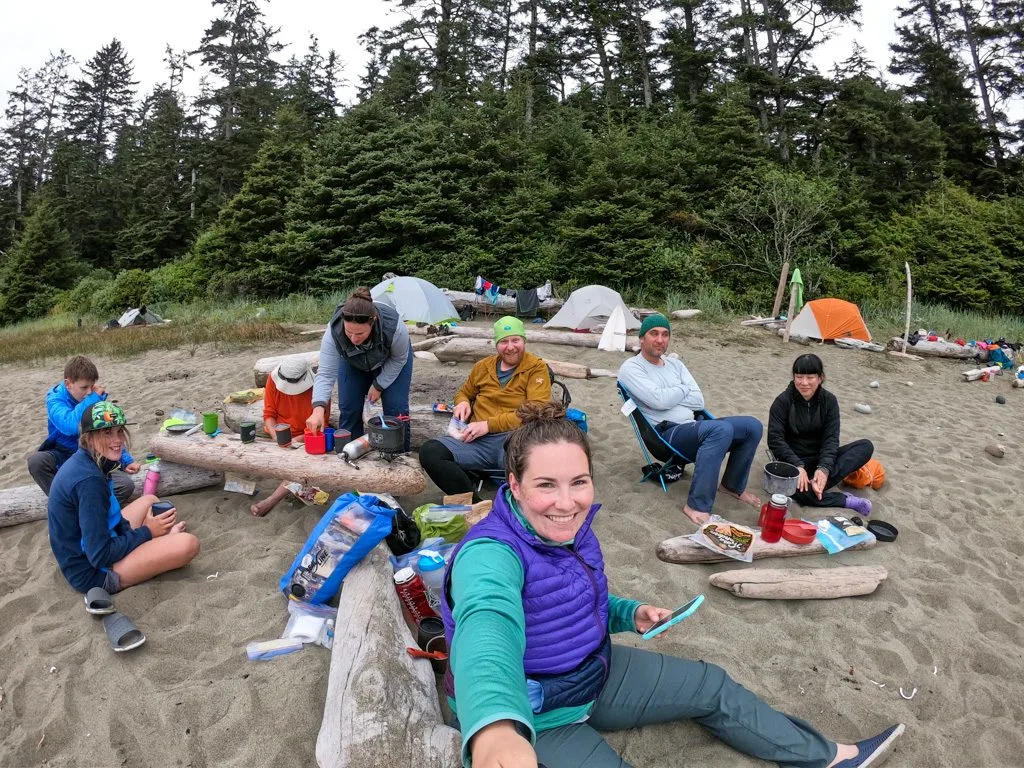
Bowl & Mug
I like the Sea to Summit X Bowls since they are collapsible and I can store them inside my cooking pot. You’ll want hot drinks to warm you up on cold evenings. I recently upgraded to a swanky Snow Peak Titanium double wall mug. It’s pricey, but it’s soooo light. Plus the double walls keep my morning tea toasty warm.
Knife and Utensils
Bring a sharp knife for cutting, plus a spoon and fork for eating. Or get a spork – they do double duty! I love my Snow Peak Titanium spork.
Dishwashing Supplies
We carry a small pot scraper, a tiny microfibre cloth, and some biodegradable soap. Use soap sparingly and be sure to pour your dishwater into the ocean. Don’t put soapy water directly into streams since even biodegradable soap isn’t safe to go directly into the water. (Read more about how to Leave No Trace.)
The GSI compact scraper has a hard edge for scraping stuck on stuff and a spatula-like edge for scraping softer stuff. We use Dr. Bronner’s for really greasy dishes and the rest of the time we skip soap and just use warm water and a scraper.
Food and Water
Water Treatment
You need to treat all the water you drink on the West Coast Trail. The streams might look clean, but there are animals and humans upstream who poop. We brought our Platypus Gravityworks filter. It is really easy to use since there’s no pumping or squeezing. You just hang it up and let it drip through.
Water Bottles or Hydration Reservoir
Bring a couple of water bottles or a hydration reservoir. There are streams at regular intervals along the trail, except between kilometres 30 and 40. I brought a Platypus Big Zip Evo 3L reservoir. Most days I just put 1 or 1.5L in it in the morning, then filtered more when we stopped for lunch.
The extra water capacity was helpful on the no water stretch between KM 30 and 40, and at Tsusiat Falls where we collected water from above the falls, then carried it down to camp to avoid drinking water people were bathing in.
Food
Bring lots of high-calorie food that is lightweight and compact. Don’t forget the snacks! You’ll burn more calories hiking than on a usual day so don’t be afraid to pack a little extra. Check out my tips for choosing the best backpacking meals and my guide to making cheap backpacking meals with grocery store ingredients.
Food Bag
To protect your food from bears and other critters, you need to store your food either inside metal food lockers, hung on a food pole or hung in a tree. We used a lightweight dry bag to store our food. They are waterproof and the roll-top cuts down on odours, so animals will be less attracted to your food.
We used two SealLine Bulkhead View dry bags. They’re waterproof, they have a purge valve to squeeze out excess air and the window makes it easier to figure out what’s inside.
Optional Extra Gear
Trekking Poles
The West Coast Trail has a LOT of uneven terrain where it can be tricky to keep your balance. They’re also helpful for stream crossings. I bought trekking poles for my first West Coast Trail hike back in 2004 and have been a convert to them ever since. If you already use trekking poles, definitely consider taking them on the West Coast Trail.
However, they do have a few downsides: they get in the way on the ladders so you have to stow them, and they can get snagged in boardwalks. Despite that, I think they are definitely worth taking. I brought my Black Diamond Alpine Carbon Cork trekking poles on the West Coast Trail and was really happy to have them.
Bathing Suit and Quick-Dry Towel
There’s nothing better than a swim after a day of sweaty hiking. There are a few places to go for a quick swim along the West Coast Trail. The ocean and all of the creeks are really COLD, but on a hot day, you might not mind.
Men can likely just wear their trekking shorts as a bathing suit. Women may want to bring a swimsuit just in case, but I usually swim in my sports bra and underwear.
If you plan to swim, bring a quick-drying microfibre towel. I like the PackTowl microfibre towels since they dry fast. You can get away with a small one.
Entertainment for Camp
You’ll have a few hours each night in camp when you’ll need to entertain yourself. Consider bringing a book or some headphones to listen to music or podcasts. I always travel with my Amazon Kindle eReader so I have hundreds of books to choose from. We’ve brought the card game Exploding Kittens on a few backpacking trips and it’s always a hit.
Ultralight Chair or Seat
After a long day of hiking, you don’t always want to sit on the ground. My friend M, my husband, and I all have the ultralight Helinox Chair One. It collapses down really small and weighs about 1kg. (You can find cheaper knock-off versions on Amazon too!)
My husband and my friend M brought theirs on the West Coast Trail but I opted to leave mine at home to save weight. Instead, I brought a folding foam bum pad. It was nice to have a dry place to sit at all times. And at only 60g, I saved a LOT of weight compared to a chair. Both M and my husband used their chairs every chance they got, including snack breaks. The Thermarest Z Seat foam bum pad is a popular choice but the Forclaz Trek Pad foam seat from Decathlon is really similar and way cheaper.
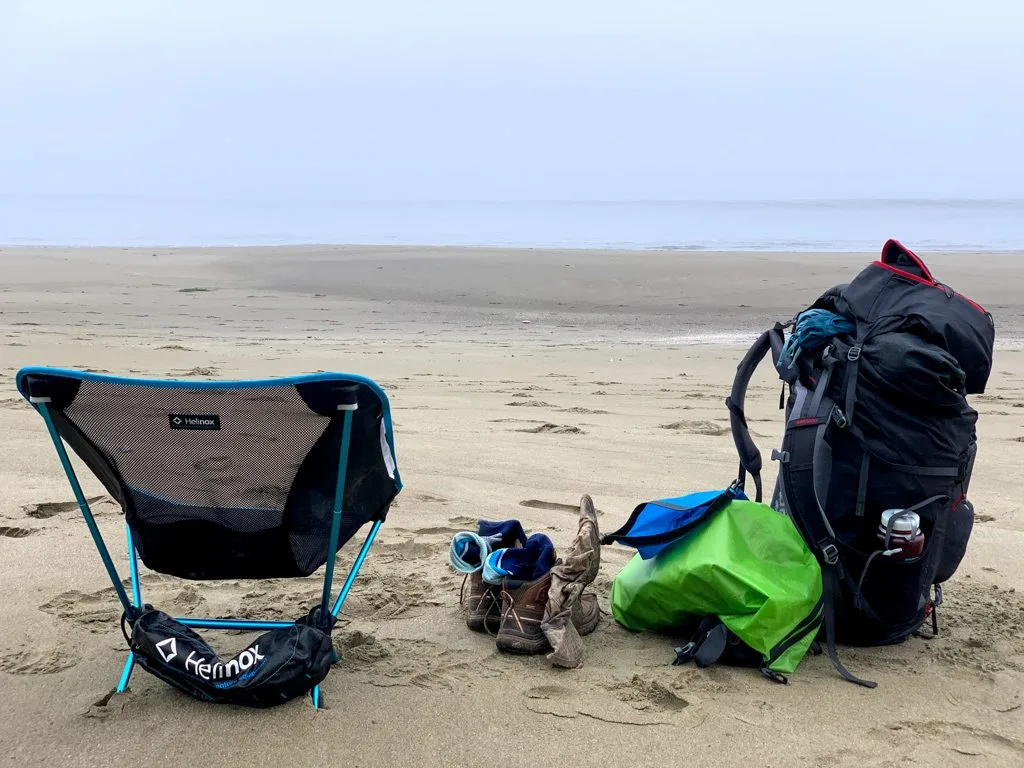
Change of Clothes for After You Finish
Pack a change of clothes to put on after you finish the trail. You can leave them in your car. If you took the West Coast Trail bus they will also bring a bag to you for an extra fee.
Join the Backpacking in BC Facebook Group
Stuff You Don’t Need to Pack for the West Coast Trail
Here’s my list of stuff you don’t need and shouldn’t pack for your West Coast Trail:
- Tons of outfit changes: Everyone else will be wearing the same stinky clothes over and over, so you can too. Plus it’s just too heavy to pack an outfit for every day.
- Portable speakers: Most people come to the West Coast Trail to appreciate the sounds of nature and prefer not to hear your music. The campsites can also be really close together, so you’ll want to keep the noise down.
- Axe: Campfires are allowed, but axes are against the rules. In any case, you should be able to find lots of small driftwood to make a fire. Remember to follow Leave No Trace best practices and make a small fire.
- Your dog: Dogs are not permitted on the West Coast Trail.
- A gun: They aren’t allowed on the West Coast Trail.
- Drones: They aren’t allowed in any national park unless you have a special use permit.
Have you hiked the West Coast Trail? What piece of gear made the biggest difference? Which gear do you recommend other hikers add to their West Coast Trail packing list? Tell us in the comments.
MORE WEST COAST TRAIL POSTS:
- Your Guide to the West Coast Trail in British Columbia
- West Coast Trail Section-By-Section Overview
- 7-Day West Coast Trail Itinerary (Plus More Itinerary Options)
- West Coast Trail Camping: Your Complete Guide
- West Coast Trail Transportation: How to Get There
- Coastal Hiking Tips: Advice for Beach Backpacking
MORE VANCOUVER ISLAND POSTS:
- Juan De Fuca Trail Guide: Backpacking on Vancouver Island
- North Coast Trail Guide: Backpacking on Vancouver Island
- Cape Scott Trail Guide: Hiking and Camping on Northern Vancouver Island
- Wild Side Trail: Hiking and Camping Guide
- The Ultimate Guide to the Pacific Marine Circle Route on Vancouver Island
- How to Visit Avatar Grove, Big Lonely Doug and Other Big Trees on Vancouver Island
- 30 Best Backpacking Trips in BC
MORE HIKING GEAR POSTS:
- 20+ Ways to Reduce Your Backpack Weight
- Why Do Rain Jackets Wet Out?
- 12 Best Women’s Hiking Pants (Picks for Every Body Type)
- Best Hiking Underwear For Women and Men
- Women’s Plus Size Hiking Clothes: The Best Brands and Where to Find Them
- 17 Ways to Save Money on Hiking Gear
- Which Women’s Hiking Gear is Actually Worth Buying? (And what can you just buy unisex?)
- Best Insulated Skirts For Hiking and Snowshoeing in 2026 - December 5, 2025
- Snow-Free Hikes in Vancouver: 50+ Year-round Trails - December 4, 2025
- 2025 Altitude Sports Black Friday Sale: My Picks for the Best Deals - November 25, 2025

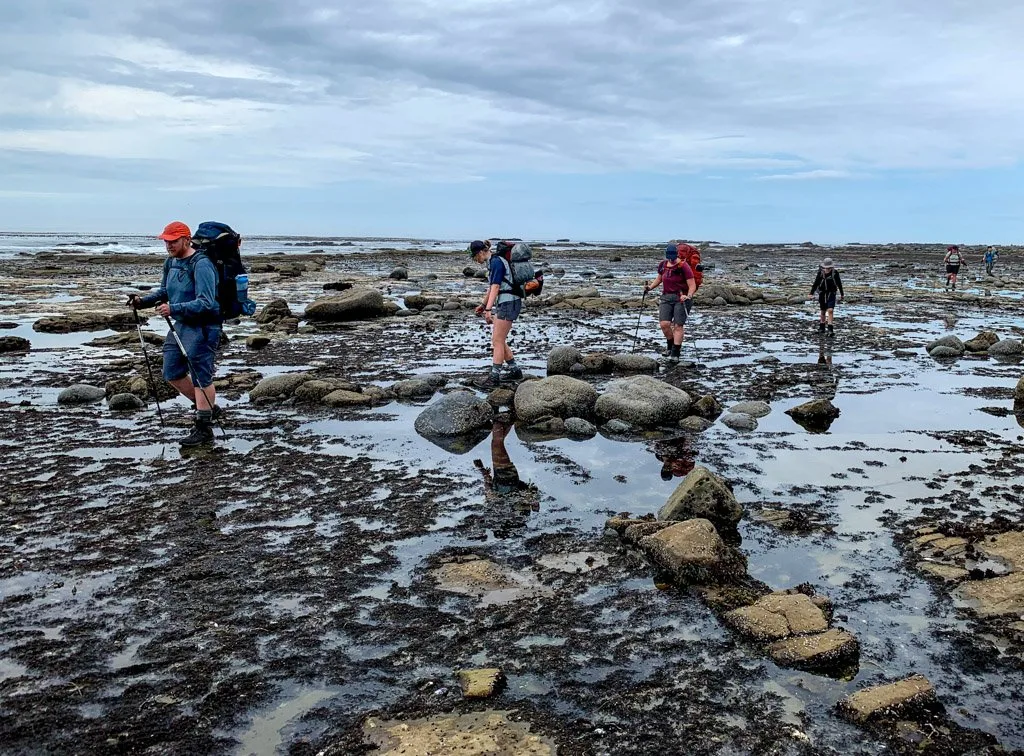
Avery
Sunday 17th of September 2023
I'm set, packed and ready to do the West Coast Trail in a couple days with a 28lb pack (thats food and water included). I must say, this is the best gear list and recommendations I've come across; I wasn't worried about my pack weight or gear list but like to research for fun. This is the only one I read and thought: "Wow these are all solid tips and really great information". Thanks for putting this out there for fellow hikers! c:
Ciara
Tuesday 1st of February 2022
We're doing the Juan de Fuca trail in April - only a 3-4 day hike. Super helpful to read your gear recommendations and thanks for the super handy links
Taryn Eyton
Tuesday 1st of February 2022
Hi Ciara. So glad to hear the gear recommendations were helpful. If you're planning to do the JDF in April, check BC Parks trail conditions reports online beforehand. Winter storms often do a lot of damage on the trail and there can be a lot of downed trees and washed out sections at that time of year.
Amy Hrenyk
Thursday 1st of July 2021
This may seem like a random question but what size of dry compression bag did you get for your clothing?
Taryn Eyton
Friday 2nd of July 2021
I actually don't use a compression bag for my clothing - Generally I use pack liner and then stuff my extra clothing in the gaps between my other stuff sacks. I use small 5L stuff sacks to store my electronics and my clothing accessories I might want throughout the day (hat, gloves, extra socks, small towel for sand off of feet). People who use a stuff sack for extra clothes often like a 15L size. But it really depends on how you like to organize your gear.
Khuaja Sing
Tuesday 30th of March 2021
The best thing I ever did was lose my sleeping bag stuff sack. Now I stuff my bag around my stuff in the pack. Fills in the spaces, pads the harder things, and no more worrying about where to put it in the pack. Waterproofing? I use an army surplus waterproof bag (rubber-lined nylon bag), but the compactor bag looks better.
Julian
Thursday 12th of September 2019
Just completed the WCT myself this past weekend! Wanted to share my some of my own insights:
1. My group brought a GPS, but it was basically dead weight because it ate through its batteries in 2 hours. I used my phone (on airplane mode) and the app Maps.Me, which uses Open Street Maps as its source. It was surprisingly accurate and a great way to judge our distance to the next milestone!
2. I know MSR has had an excellent reputation in the past (half the tents I saw on the trail were MSR!), their 2019 iteration of the Hubba series is poorly-adapted for the West Coast Trail. The reason: they stopped seam sealing their flies (and everywhere else), meaning they're ill-equipped to deal with any amount of rain. Dozens of reviews across multiple sites (MEC, REI, MSR itself) I've read online have complained specifically about the 2019 version leaking (even on the WCT itself). Their CSR suggest seam-sealing it yourself, but IMO it's a silly thing to ask people to waterproof a tent they just spent $500+ on. I used a Marmot Tungsten 2P UL myself, which help up pretty well. Other well-recommended tents are made by Nemo, Big Agnes, and Mountain Hardwear.
4. Bring extra tent pegs in case the sand "swallows" one up and you can't find it anymore!
5. I used a Neoair Xtmerm Max as well, and it was amazing. I've never spent that much on a pad before, but it was totally worth it for the warmth and comfort. I bought the large size because even though I didn't need the extra length, having the option to spread out a bit was nice!
6. I'd say trekking poles are almost a must-have rather than a nice-to-have. They were utterly invaluable for navigating the many mud pits and aiding in stability. Your downsides are valid, but they were a minor inconvenience for me compared to the aid they provided. Sometimes when doing a ladder I just held them in one hand (a bit risky, I know)! But the BD poles you mentioned (and their cheaper version, the Trail Trek) are so easy to collapse and stow.
7. I scoffed at people bringing their ultralight camping chairs, but after sitting on rocky driftwood for 6 nights, I kinda wish I brought my REI FlexLite! The Z-seat is a brilliant suggestion though and I'm adding it to my shopping list for the next backpacking trip.
8. There's a difference between packing food for caloric fulfillment vs. stomach filling. My friends (2) and I packed for calories and ended with way too much food, even though all of our meals were homemade and dehydrated, and we brought protein bars, trail bread, etc. Probably ended up with a couple pounds each of excess food at the end of the trip because we physically couldn't eat everything.
9. An alternative water treatment to a gravity filter is Pristine Water (chlorine dioxide). They're two eyedropper-sized bottles that can treat virtually any volume of water in 20 minutes, provided you have enough containers to store them in. Virtually zero aftertaste after 30 minutes!
10. I brought my Tevas for water crossings, though I never needed to use them (thankfully) and only busted them out at camp. The downside, they were slow to dry so I almost wish I had a pair of camp sandals/flipflops AND water sandals for wading!
11. If you can afford it, merino t-shirts are the way to go. Like wool socks, they don't get nearly as smells as quickly as synthetic clothing does! And it's great at keeping you warm if you get wet.
12. For a synthetic midlayer, I highly recommend the Outdoor Research Ascendant Hoody - it's think but surprisingly warm!